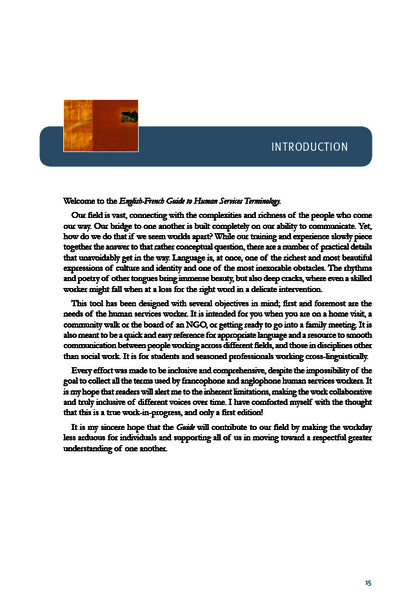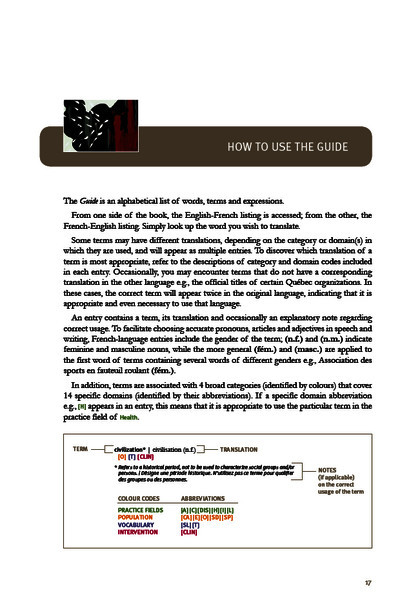The Making of: Le Guide Français-Anglais de la Terminologie des Services à la Personne
The relationship between technology and Social Work could be likened to the relationship between oil and vinegar; they don’t mix. My first position after graduating from McGill was in a community hospital in Montréal. I started in 2000 and did not receive a desktop computer until I left to become a teacher at Dawson College in 2005. While our profession requires extensive interaction, advances in communications technology have not reached us easily.
Another void I faced when beginning professional practice was the lack of support and resources for Human Service workers in bilingual environments (Social Workers, Psychologists, Educators, etc.). While my hospital had official English language status, we served less than 50% of our patient base in English – and the vast majority of my colleagues were Francophone. Add to this the complexity of being a teaching hospital for students from throughout Canada and the world and our location in one of Montréal’s most multicultural neighborhoods.

Cover of the English-French Guide to Humain Services Terminology.
I regularly assisted people with severe and persistent mental health problems who often had to navigate a maze of services in the course of a day, not an easy task given the symptoms of their conditions. I remember one phone call in particular when I was struck by the difficulty of intervening with a Francophone gentleman who was experiencing delusions. I thought he said a frog was trying to kill him and move his undead body to St-Jérôme, but I would have felt more comfortable assessing him if I could have been sure of his meaning.
While I was at Dawson, I continued to discover that professionals throughout the Human Services delivery network were struggling with these same issues. When I saw the CCDMD’s call for English-language proposals, I immediately saw this as an opportunity to develop a translation tool for Human Service workers.
In our field, we have many words that simply do not exist in regular dictionaries. We also need terms from several specialized dictionaries. In my work at the hospital, for example, I needed medical terms (schizophrenia, anorexia), social work terms (psychosocial assessment, groupwork) and immigration, theory, and aging terms, among others. I also had to learn the correct usage of a word like “retardation”, appropriate as a legal term and medical diagnosis but derogatory when used in other contexts. Another example of respectful language use is seen in the word “disabled” – in French it is translated as “handicappé”, but in English “handicapped” is pejorative and inappropriate.
Technology and Social Work may be like oil and vinegar, but with a good tool, some creativity, and a lot of hard work, what could be better?
The CCDMD accepted my proposal and confirmed the need when the consultation meeting drew a record crowd of 25 professionals in the field, with equal Francophone and Anglophone representation. My research soon outgrew what was originally intended to be an easy reference pocket book for use on the road. The research was extensive and inclusive, with over 150 provincially based agencies and organizations being solicited for existing lexicons and needs, in addition to the Web and print-based hunt for content. Focus groups were held with professionals and students, and ultimately a multidisciplinary team of 22 people lent their expertise to development and translation.

Sample Page
Excel was the original software used to organize data, but after I had collected about 200 words and terms it became unwieldy and frustrating to use. Thankfully, the CCDMD agreed and graciously funded the development of an online database. This enabled me to work with the larger team over the Internet and more easily organize the various types of information (term, translation, masculine/feminine notation, explanations for respectful use, etc.) and structure the content by domain (Health, Crisis, Clinical, etc.).

Introduction Page

How-to-use Page
The database had its share of glitches; my project manager and I frequently joked about our new repetitive stress injuries acquired after checking what turned out to be over 20, 000 terms! We were effectively beta-testing the database, although it was our main tool for creating the book. Ultimately, the project inspired a number of other CEGEP teachers to propose similar work for different disciplines. Given the continued interest and the evident need in Québec for adequate translations of specialized lexicons, the CCDMD is currently developing a new and sophisticated database to facilitate data entry, storage, organization, revision, and output.
When the content was finalized, the CCDMD found a wonderful graphic design team who worked with me to integrate my original paintings and collaborate on the overall aesthetic of the book. The book is now published, three years after beginning what I initially expected to be a one-year project. It is 500 pages, colour-coded, and costs $68.00. Following our program review at Dawson that recommended improved French instruction, the Guide is now a required text for first year stage seminars. It has also been adopted in France at several Institut Régional de Travail Social with whom further collaboration is planned following the France-Québec accord to recognize Social Work professionals from each location at par.
My vision now is to promote the tool and further develop a collaborative system for revision, where new language and new language uses can be added. We can redefine our definitions together so we are referring to each other in ways that best respect our unique identities. In other words, we hope this tool will be the ‘go to’ source for respectful language across disciplines and remain current to the evolution of each language. There is no doubt that the new online database will be a necessary step in achieving this.
Technology and Social Work may be like oil and vinegar, but with a good tool, some creativity, and a lot of hard work, what could be better?
Express your views on this subject by using our Comments feature!

